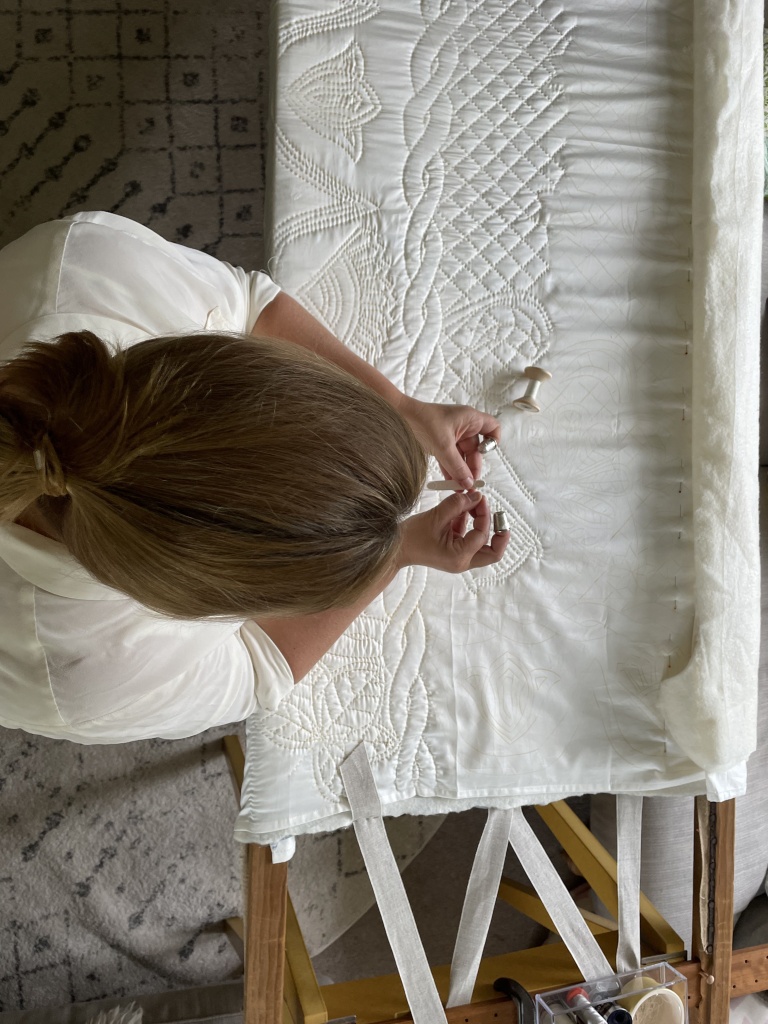
I quilt in a flat frame. It is a technique that seems to invite a curious fascination, carrying as it does, a lot of historical baggage. This blog post aims to answer some of the questions that I regularly receive, and also to address some of the common misconceptions that those reactions are often based on. It is a peculiarity of modern quilt making practice that hand quilting in a frame remains such a niche undertaking. Quilting has almost universally been done by hand for most of the history of the quilt, even until relatively recently. For most of that time, in Britain, it was done in a frame. Yet so few resources to find out about this history exist.
Despite the invention of the sewing machine and its rapid adoption by pragmatic makers in the last decades of the nineteenth century, it took until the computerised machines of the end of the twentieth century before anything other than the most rudimentary quilting could be reliably finished by machine outside of a factory setting. Despite this ubiquity and the relatively recent history of the frames demise, very little residual knowledge remains about the use of quilting frames. My own curiosity as a quilter led me to explore this topic through my academic work. This post aims to give some basic background of what I found, whilst asking us all to think again about what we lose when we don’t interrogate our history. What might we learn by revisiting the history of the quilt frame, and why have we been so reluctant to do this in recent decades?
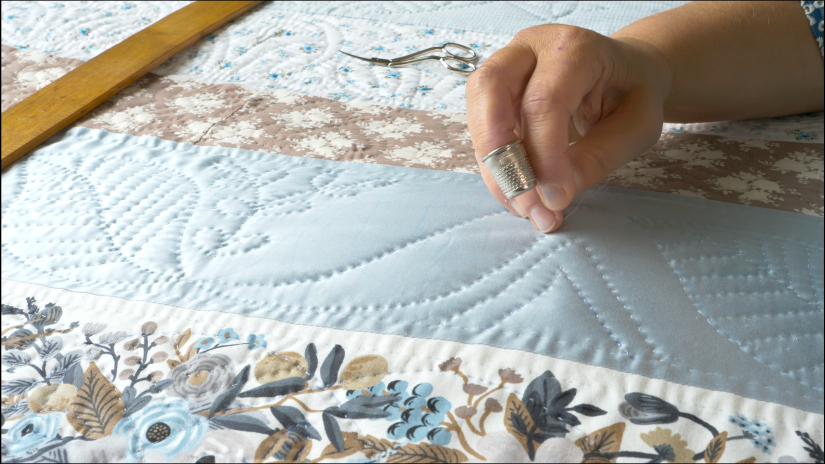
The art of pattern making can be seen as a response to the constraints of the technology of quilting. Quilting in a flat frame imposed certain conditions which created identifiable patterns that worked best for the frame. Quilting on a sewing machine has its own constraints which changed the nature and look of quilting again. Domestic sewing machines with stitch regulation and the adoption of long arm quilting frames by home sewers created, in effect, a whole new creative genre, and with it moved the centre of gravity of quilting away from the hand sewer. The all-over quilting patterns that we see today are evolved to fit the technology of the machine, in the same way that the quilting patterns of the past were an intimate fit with the constraints of hand quilting in a frame. When we look at old quilts we are looking at a style shaped by the quilting frame.
As that move occurred, and as quilting by hand in a rocking stitch on a flat frame stopped being an experience that most quilters had any familiarity with, many misconceptions and half truths about hand quilting started to take hold. (You might also enjoy this short film made for The AHRC Inheriting the Family Network for more footage of the quilt frame in use if you aren’t familiar with the technique). This post aims to answer some of the many questions that I once asked, and subsequently that I am now always asked about quilting in the frame, particularly in the British context, and I hope it will serve as a permanent resource for quilters looking to find their way back to a quilting experience that was once so commonplace that so little was written about it.

“Quilting in the frame looks more difficult than sewing in a hoop, or just in my lap without any aid to tension”
This is the most common comment that I frequently hear and it comes from two widely held misconceptions. The first is that tension works against you when you are trying to sew. Many modern quilters feel this because they are using the needle in a ‘pencil grip’ the way that any of us would sew when doing a ‘normal’ running stitch. This style of sewing requires us to work the needle down through the fabric layers and then pop it back up, effectively twisting the needle upwards. This is much easier to achieve when no tension is working against the pliability of the fabric and when we can use both hands to manipulate the needle and fabric.
However, quilt frames evolved alongside a form of stitching called a ‘rocking stitch’ a kind of tailoring technique which was used for quickly sewing long seams by hand in a time when that was the reality of most peoples sewing, for example, seaming narrow loom widths of fabric to make bedsheets. Rocking stitch requires the sewers to don either a thimble on each hand, or to have built up sufficient callus that no finger protection is needed. The sewer then balances the needle between the thimbled top finger and the finger on the other hand which also wears a thimble and sits below. The needle is then rocked between both thimbles without the sewer ‘holding’ it in any grip at all. You can see this in the short film above or the longer film linked in this post. This unique method allows many small stitches to be effortlessly loaded onto the needle – resulting in fast and even rows of stitching. The tension of the frame is critical to this technique because both hands are in full use – there is no way to hold the fabric, the tension of the frame allows the rocking to be carried out quickly and efficiently in long runs covering ground quickly and evenly.
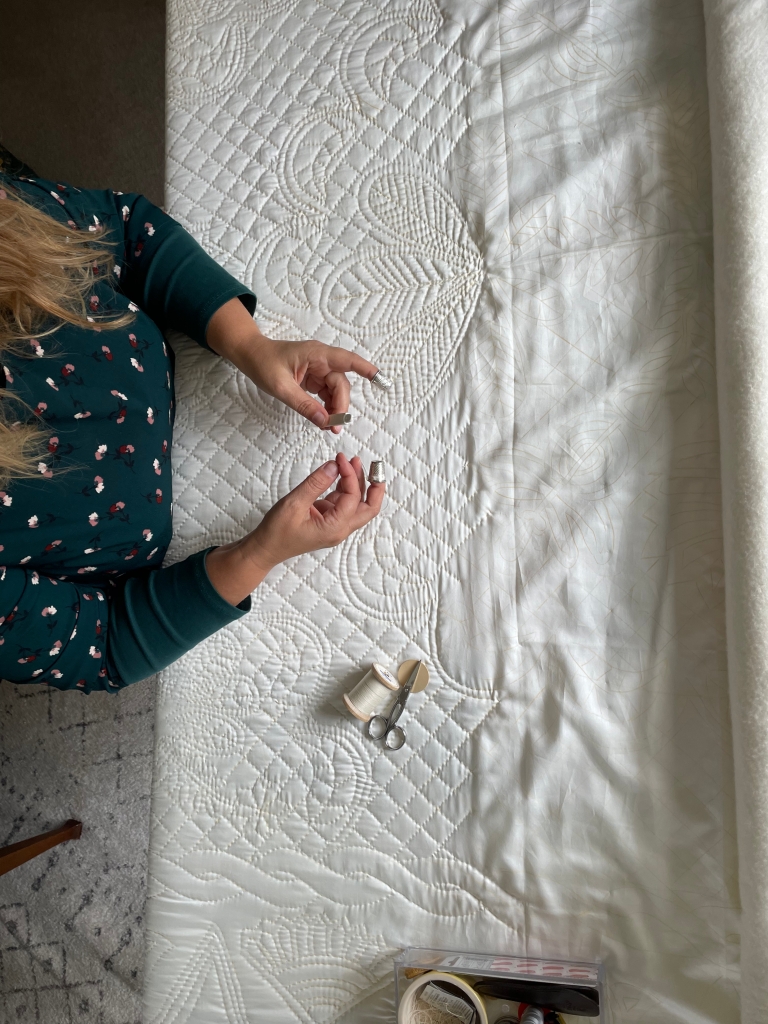
A hoop also works for rocking stitch, I sewed this way for many years, but a frame is more stable and gives the sewer more control over the crucial movement to ‘pop’ the needle back up to form the stitch. For me, this results in smaller and more even stitches than sewing in a hoop.
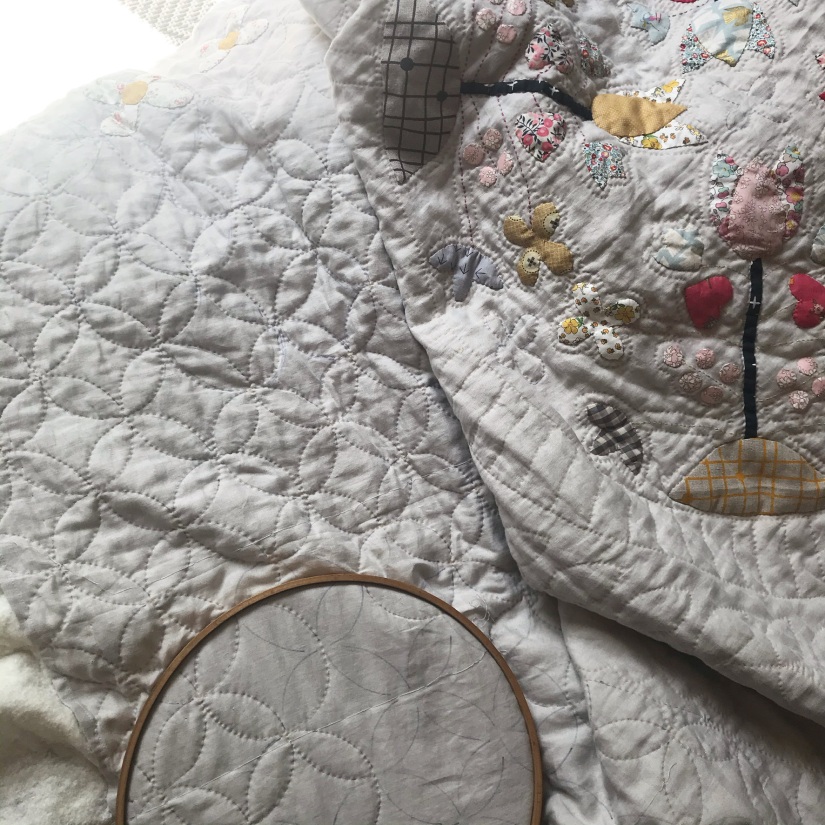
A second and crucial reason why the frame was used in the past over a hoop was that wadding was not a single material for most of the period of the quilting past, and in many places where wool (and in the US, cotton) could be obtained locally and cheaply frames persisted longer. Thus, wadding needed to be added to the quilt as you went along, as each ‘pass’ of the quilting bought a new strip of the quilt to the flat top of the frame, the top would be lifted up and the wadding combed and laid to create the right amount of loft.
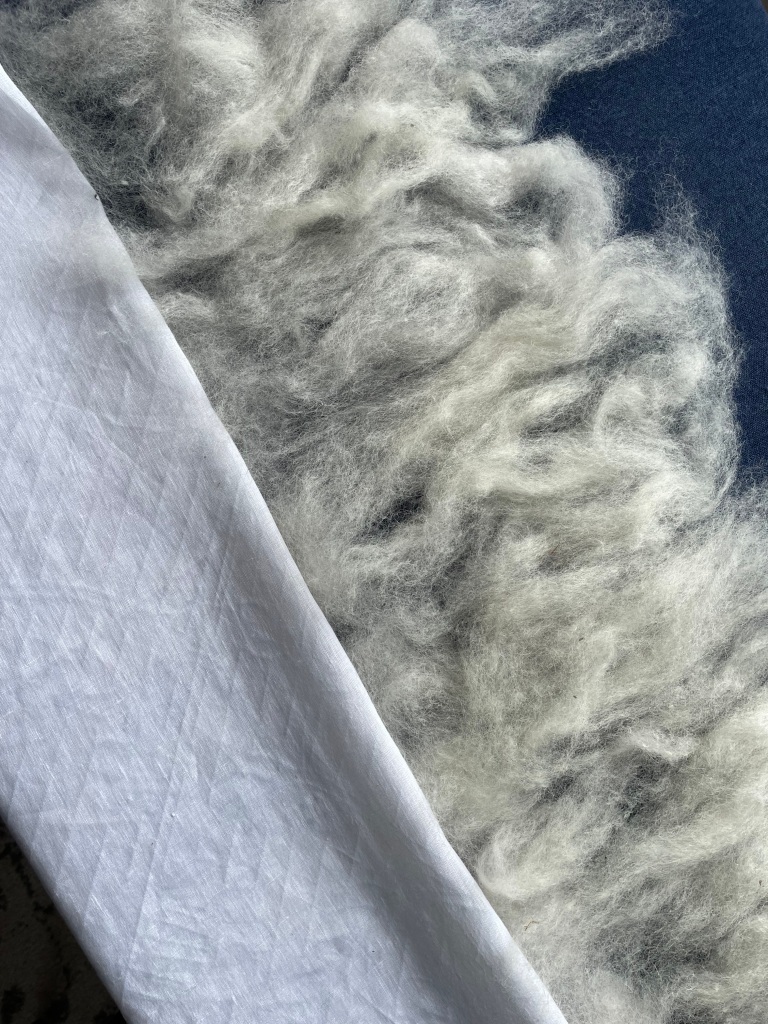
The wadding would lay flat, but un-tethered, ready to be quilted over, and then the quilt wound on again. It was simply not possible to do this in a hoop and achieve any kind of even layer. Thus we might see the frame as evolved perfectly to match the conditions under which quilters most commonly worked for most of the recent ( last 300 years) quilt history.

“Quilt frames are large (and expensive today) so quilters who used a frame must have been privileged. What about ordinary quilters in the past?”
This is another frequent question, which is rooted in how we see quilting today, and in how we use our homes today – both very different than in the past. Quilt frames were most commonly (especially before 1900 in the UK) made up of just 4 lengths of wood that created a pegged frame that could rest balanced on a table, on the backs of chairs or on trestle legs. These frames were cheaply built by family members who only needed rudimentary skills to make them, or easily obtained from accessible local carpenters and cabinet makers.
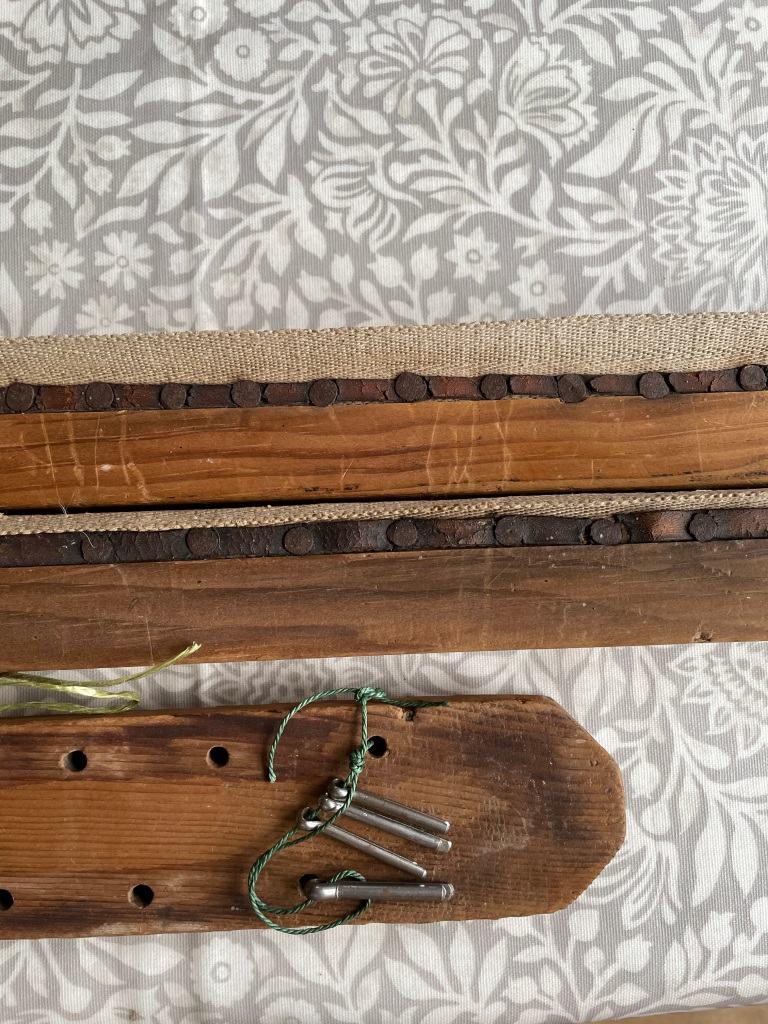
Moreover, quilt frames were household tools that lasted generations, borrowed between neighbours and extended family, ultimately passed down generations in bequests and gifts. Frames were used as tools, rather than as objects of leisure as we might see it today. Few makers other than those who worked as professional quilters would have seen themselves through the modern prism of identity as a ‘quilter’. Quilt making was a skill like making clothes or bread that was part of many peoples domestic lives and which they drew on as and when they needed it. The frames would be set up ( a moment sometimes recorded as an ‘occasion’), the quilt worked on for weeks or through a season and then the frames stored neatly away again, just 4 pieces of wood stored in the rafters or stood in an outhouse.
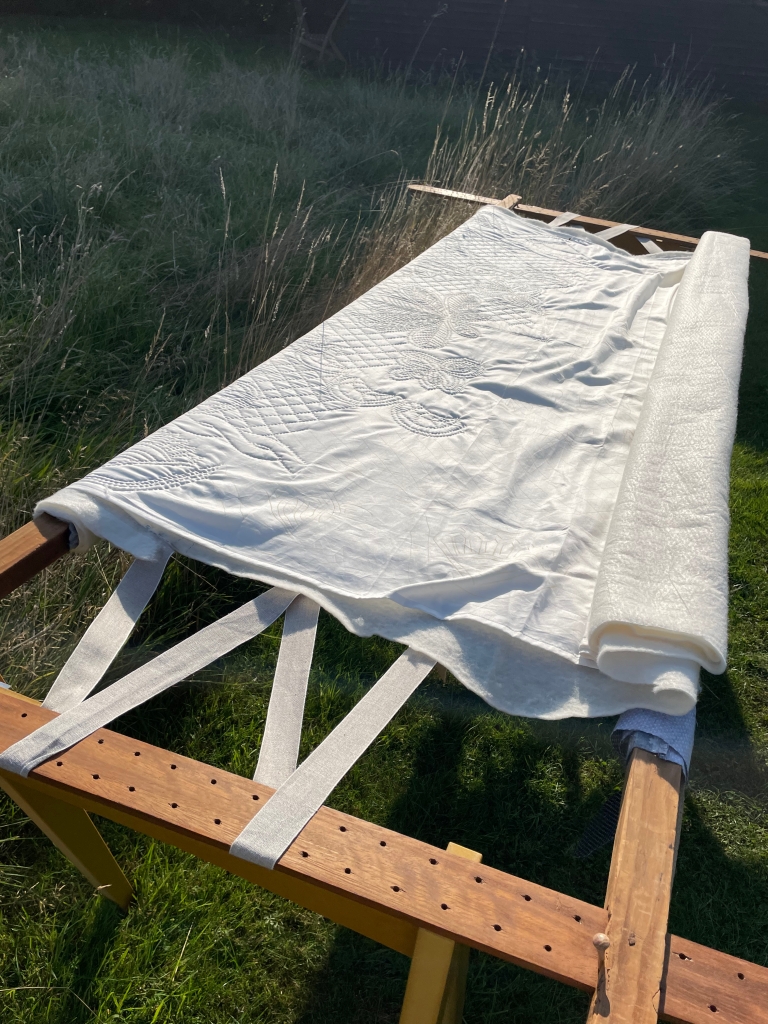
It is also important that we don’t impose modern understanding of the use of domestic space on the past. Whilst quilt frames are large and unwieldy they were no less of an imposition on the family kitchen or backroom than the permanent airers needed to dry clothes in winter, the copper water boiler or bath, or any of the other large, occasional tools, that were needed to run a domestic enterprise and that the family shared space with. Living spaces were sparce of permanent furniture (no kitchen work surfaces etc) but also more pragmatically used. Frames might have been set up in the cosy back kitchen in winter for the family to work around, or in the cool front room in summer when the open fire wasn’t lit and the space in front of a fireplace could be utilised as ‘extra’. Space as a luxury was less prized when lives were lived more fluidly between outdoors and in. The frame could bring a family together as much as drive them out.
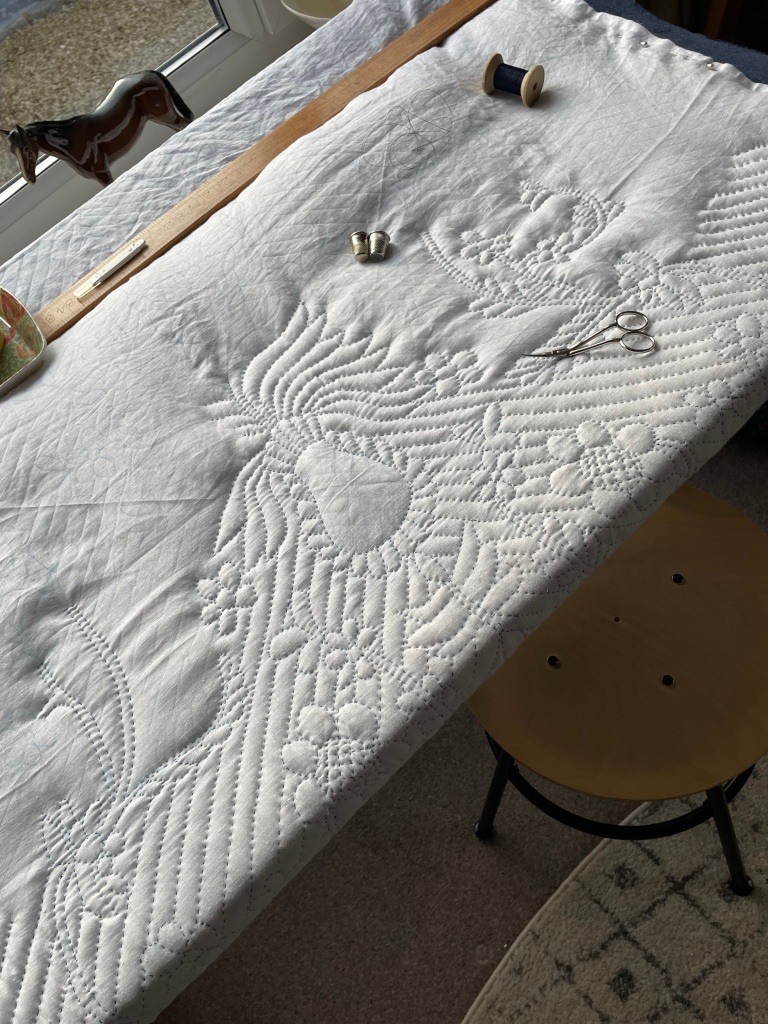
We sometimes conflate American quilt history with the often very different traditions as they evolved in Britain. When we associate quilting in a frame with privilege we likely draw on images such as of the impeccably quilted east coast American Baltimore quilters stitching immaculate appliqué and hand quilted treasures in their elite homes. The reality in Britain ( and, of course, in many other parts of the society and geography of the US) was very different. Quilting in a frame was only associated with elite makers for a short period in the UK, perhaps between the last decade of the eighteenth century and the second or third decade of the nineteenth.
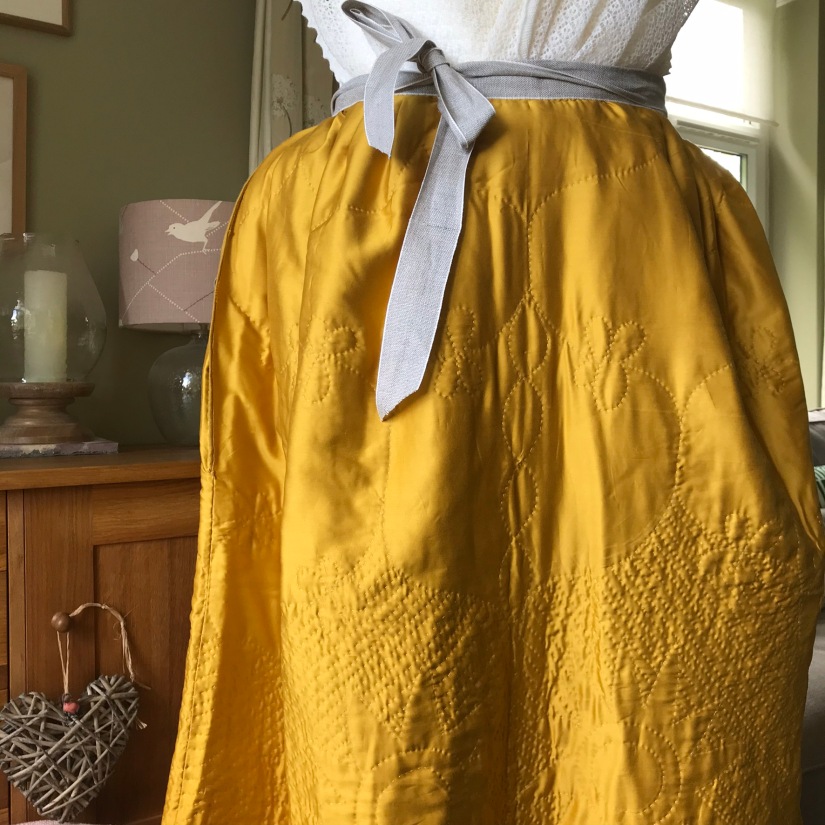
Before the end of the eighteenth century hand quilting was done largely by professional, poorly paid, men and women who stitched to order. By the end of the Regency quilting at home had become increasingly unfashionable, continued mainly by the newly emerging middle class, particularly in the provinces – by busy and industrious wives and daughters of vicars, farmers or merchants, stitching objects to elevate their homes rather than done by the rich and leisured. The further into the nineteenth century we venture, the further from fashionability and wealth hand quilting travels, surviving in upland farming communities in the north and Wales and amongst the wives and daughters of miners.
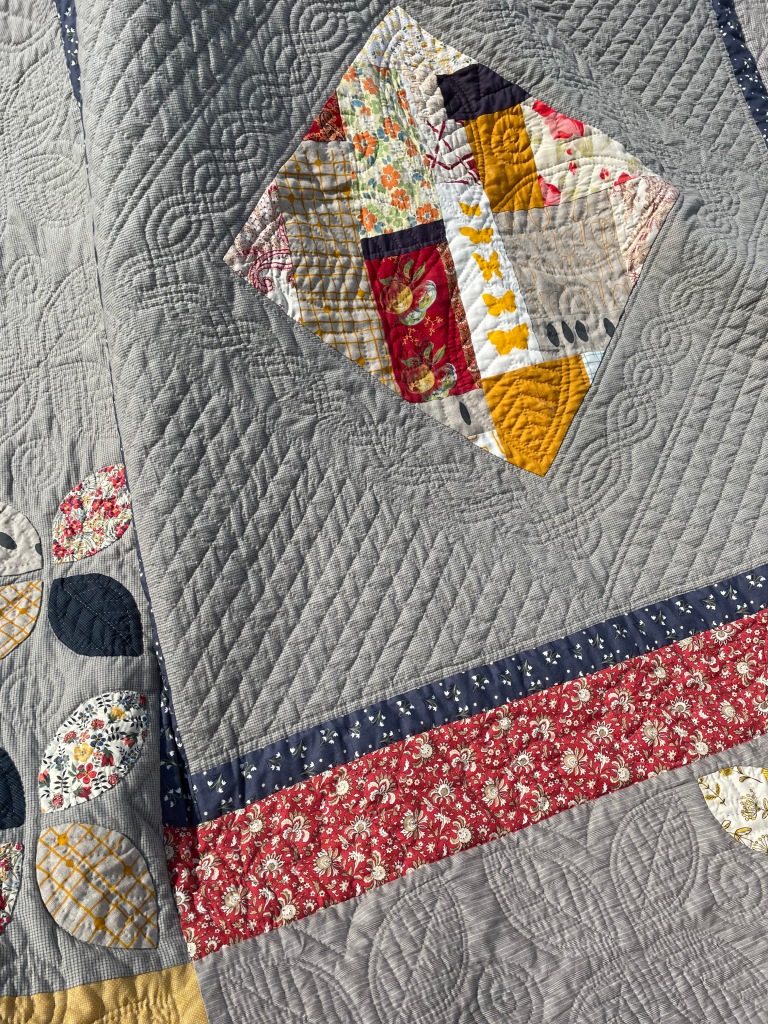
There is little correlation between the finesse of the quilting and the wealth or leisure time of the maker – another easy but incorrect association that is often made. Many of the fine hand quilted covers were made in conditions of relative poverty (although the makers may not have seen their conditions as such).
It is a kind of condescension to suggests that beautiful things might only be the preserve of the wealthy or privileged and that work of the ordinary maker must be always be quick, rough, folksy or naive. Hand quilting offered a rare democratisation of beauty, requiring as it did only a frame, thread and perseverance to create items of great skill. Whilst we might consider that the time to sew was a luxury, accounts from the past show us the ways that working women engineered time in their busy lives, considering the time to quilt as a necessary job that needed to be done in the same way that they ‘found’ time to prove bread or starch collars or feed and milk cows.
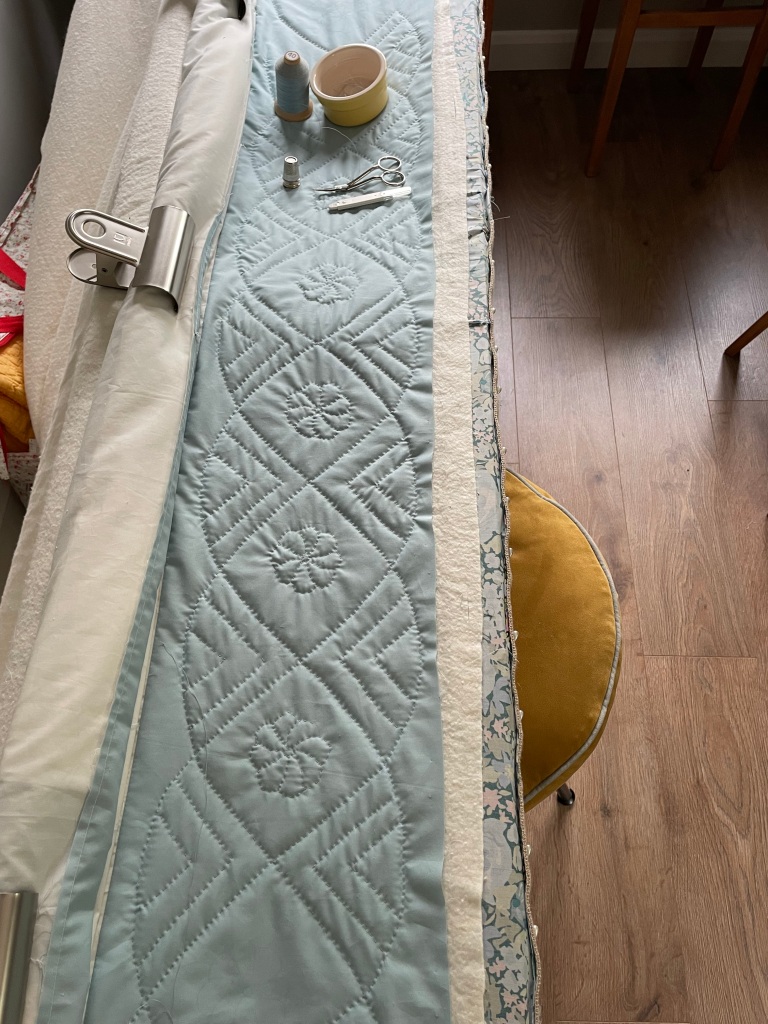
We must also be careful not to conflate the histories of patchwork with quilting. For much of this period the stitching of patchwork might be found in more fashionable parlours, but hand quilting skills remained a technique that was mostly absent amongst the upper middle and higher classes and that thrived, evolved and flourished in the homes of the labouring, farming, mining and working people.
“The aim of hand quilting in a frame is to make ‘perfect’ stitches and that’s just not my vibe.”
This is another connection whose roots lie tangled in a range of changes to women’s lives and wider society. ‘Perfect stitches’ are only an almost inevitable outcome of efficiency when quilting in a frame. As the maker gets more skilled at balancing the powers on the needle between thimbles, then the stitches automatically become more even. When hand quilting in a frame was the work of professional makers, then quality and evenness of work as well as speed were valued. As quiltmaking became something that was more domestic, then these considerations might be less of an issue depending on the approach of the individual when the utility of the quilting stitch could be at least as important as the look of the object.
Thus, historically we see a real range of different approaches, from what we would call ‘big stitch’ finishes today to extremely ‘fine’ stitching in complex patterns yet completely hidden by busy printed cottons. We also see patterns which at first glance seem complex, for example twisted cables, which when stitched towards the quilter and marked quickly with a single simple rudimentary template could render a quilt well attached and beautifully decorative. We often see these patterns in old quilts but our modern eye perhaps fails to read them as ‘simple’ and ‘pragmatic’ patterns because we lack the material literacy of the knowledge of what makes a simple pattern to mark or stitch in a frame.
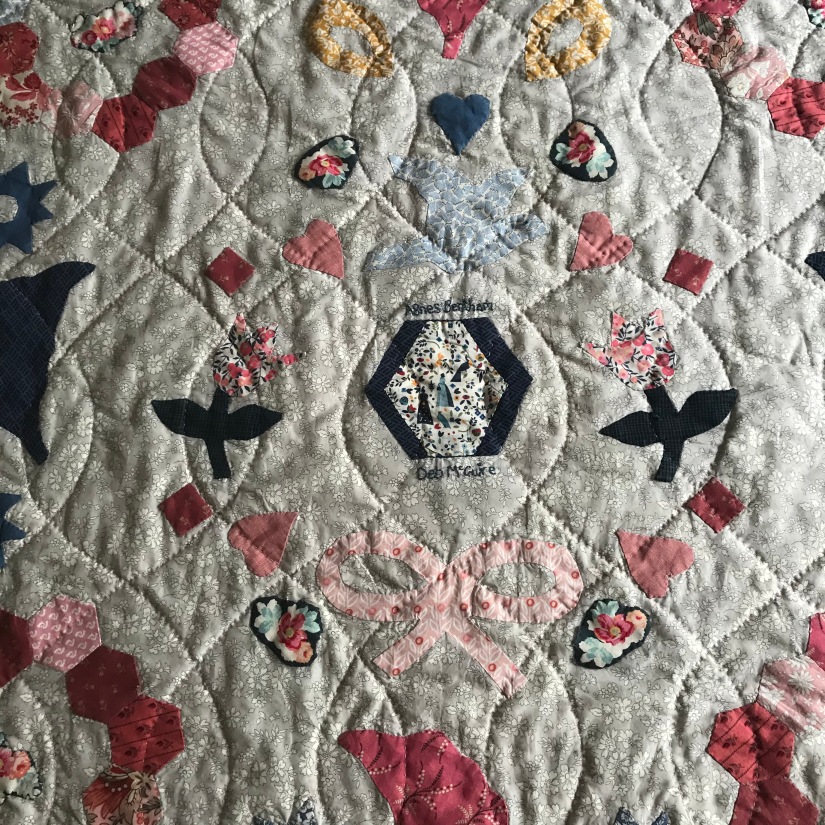
Yet the re-emergence of quilting as a skill visible outside of the home at the end of the nineteenth-century came with the Victorian rise of the technical or industrial show. In this environment quilts were ‘shown’ competitively for the first time and were ‘judged’ and thus criteria of ‘good’ and less good quilting was widely imposed. In the wider context of a society that was codifying production and quality in new ways as the industrial revolution swept through, it is no surprise that evenness and reliability of stitch was valued. People needed to be able to demonstrate the same skill as a machine.
In the twentieth century the rise of women’s groups such as the Women’s Institute, quilting Guild’s and groups continued to codify these standards, it is in this relatively recent past that the concept of stitch perfection lies. This means that there is often a knee jerk rejection at the perceived constraints of hand quilting in a frame as something from a rejected bossy past that speaks to an imposed formulaic way to excel in quilting. Arguably today we have turned another page, perhaps a post industrial one, where we increasingly value the handmade as a sign of care, quality and individuality. My argument is that the frame should be rightly embraced as a democratic tool that historically allowed all to access the skills of hand quilting to make items of breathtaking beauty.
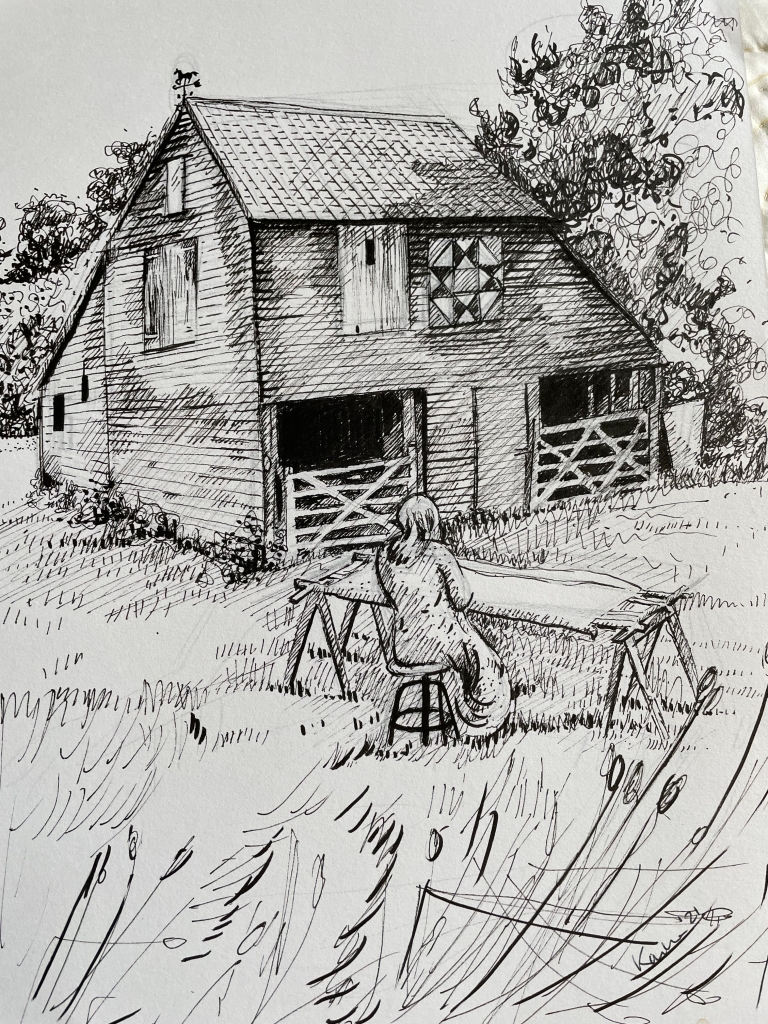
Whilst the context of hand quilting today is very different to that in which it was practiced in in the past, it is a technique that can offer the curious much. My own fascination lies in the wider demands of my work as a quilt historian with an interest in the History of the Emotions. By making quilts by hand in the same ways in which they were made in the past I gain insight into a range of issues. I might better understand why patterns are shaped as they are, understand terminology and description more vividly when I have also done that same action – loading a frame or preparing wadding, I can hope to come closer to understanding the investment of time and emotion in the making of a quilt in the past, and I gain technical knowledge of how an old quilt was made, finished or repaired.
Quilt frames remain a shadowy omission from most modern quilters knowledge of the quilting past. Whilst I don’t necesarily expect that they will become ubiqutious again, I so hope that more quilters are also curious about their role in developing the craft that we all feel so passionately about engaging in today. Far from being a dinosaur from the past, quilt frames offer us some valuable insights into quilting’s future. We increasingly recognise the balancing benefits of creative rest and engagement that quilt making gives in a digital age. But, we also need to use less and make it last longer. Hand quilting offers mental rest, creative challenge and a project that lasts all year. Rather than churning out 12 quilts a year as quickly as possible, modern makers might think about how we make the pleasures that we gain from this stitch balance more sympathetically with the world that these quilts will continue to live in. Whilst quilts in use are often gentle objects of care, the global textiles industry that feeds their making can be anything but. By slowing down our making, savouring the journey and enjoying building skills we take the best from the past to build a better future with more beautiful sustainable quilts.




Thank you for this informative and insightful article.
LikeLike